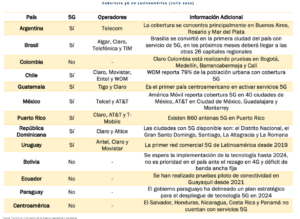Since mobile telephony appeared in the late 70's and early 80's we observed an increasingly rapid advance of telecommunications. Since then, we've witnessed how we went from making simple phone calls to sending multimedia files and even banking from a smartphone; and with the arrival of 5G and its adoption in Latin America, its benefits and the challenges to adopt this technology become evident.
5G networks promise numerous advantages, in addition to those we already expected such as speed in navigation and greater capacity to process large volumes of data, this technology will go much further and will have a real impact on industries such as entertainment, tourism, smart cities, health, education and security, connecting more than 350 million devices to the network only in Spain during 2023.

Features of 5G networks
While the 4G network allows a maximum download speed of 1 Gbps, the 5G network will allow a download speed 10 times faster (10Gbps), another fundamental aspect to understand the advantages of the fifth generation is the improvement of latency, which promises to be 1 and 2 milliseconds, unlike the 35 and 52 milliseconds we currently have in 4G. This will allow the construction sector, for example, to operate machinery remotely.
The Internet of Things (IoT) will be the big winner with the adoption of the 5G network, according to Statista, it is expected that by the end of 2025 there will be approximately 1.2 billion IoT connections in Latin America, and will supply close to one billion IoT devices available in the region.
According to data from Omdia and 5G Americas, published by BN Americasworldwide the adoption of 5G wireless networks has doubled year after year to reach 813 million connections by the end of June 2022 and by December 31, 2022, 1.1 billion 5G connections are projected in the world.
However, while a total of 108 million 5G connections were registered in North America at the end of 2022, Latin America and the Caribbean is projected to register 22 million 5G connections by the end of 2022a figure that will increase by 399 million by 2027.
5G advances in Latin America

5G benefits and its adoption in Latin America
The delayed reality of 5G adoption in Latin America with respect to countries such as the United States or South Korea is evident. Argentina, Brazil, Chile, Guatemala, Mexico, Puerto Rico, Peru, Dominican Republic, and Uruguay are the only countries in the region that have commercial coverage of 5G networks, of these Chile and Puerto Rico stand out as the countries with the most developed 5G ecosystems in the region according to the report State of 5G Coverage in Latin America carried out by The CIU in 2022.
If we talk about the Central American region, Guatemala is a leader in the adoption of the 5G network, however, with a limited scope for Guatemala City. Even so, its effort to modernize and accommodate the radio spectrum is an example for countries such as El Salvador, Costa Rica, Panama or Nicaragua that still do not have these services.
In the Caribbean region, Puerto Rico and the Dominican Republic were the first with commercial 5G deployments, benefiting from being small markets that may even turn off their 2G and 3G networks in the very near future.
It is necessary to mention Chile, since it was the first territory in Latam to turn on its fifth generation networks nationwide at the end of 2021, driven by its mobile operators Movistar, Entel and WOM. Entel, for example, projected about 400,000 subscribers under this technology in 2022.
Only 50% of 18 countries analyzed in the Latin American region have coverage and commercial availability of 5G mobile services.
An expert look

Fernando García, MD in IDP Data Centers
Ingeniumlatin American leader in Data Center development, spoke with Fernando Garcia, MD of IDP Data Centers about the challenges and importance of adopting the next generation of telecommunications. The expert pointed out the benefits it will bring to sectors such as agriculture, livestock and transport, but also emphasized the need for governments to generate the necessary conditions to expand 5G coverage.
In Latin America, Brazil and Chile lead the deployment of 5G technology. What is the main challenge for other countries to be interested in implementing 5G?
"The main challenges have to do with the management of the radio spectrum and the auctions of the corresponding frequency sections, updating the regulations for the right of way and use of antennas on rooftops, and public and private spaces, and ultimately allocating a huge amount of public and private investment. In addition to Chile and Brazil, the Dominican Republic and Uruguay have already auctioned the corresponding frequencies, and it is expected that Mexico and other countries will also do so soon."
What should LATAM countries learn from Europe and Asia for the adoption of 5G?
"Governments must regulate, and demand from operators, 5G coverage by providing the appropriate legal frameworks so that the enormous investment that operators must make has the maximum institutional guarantees.
According to Statistathe six largest economies in Latin America – Brazil, Mexico, Argentina, Colombia, Chile and Peru – would need to jointly invest a total of 120,000 million dollars for 5G technology to be deployed throughout their territory with a uniform speed of 50 Mbps; This makes evident the need for more expeditious regulation that provides the necessary guarantees so that all those involved obtain the expected profitability."
What is the importance of governments opening the eye for operators to deploy 5G on frequencies dedicated to this technology?
"Opening up spectrum to the right frequencies for 5G allows the latest technologies to be used that make full use of the benefits of 5G such as latency, speed and simultaneous number of connected devices.
We must remember that the radio spectrum is the raw material for the telecommunications sector to move towards 5G, it is a limited resource, therefore, effective use must be made of the available frequencies to avoid interference".
How long will it take for Latin America to see the tangible benefits of 5G? When will we fully enjoy its uses?
"It may take more than 10 years for Latin America to see the full benefits of 5G. The region remains one of the lowest in revenue per line and more than 90% are still prepaid, so operators fail to monetize 5G investments.
This means that by 2025 the 5G reach is 10% in countries such as Mexico and Brazil, as any immersive technology, expansion plans must mature, learn from the leading countries in the field and think of new ways to realize this experience. The modernization of mobile technology will not stop and will take accelerated steps in the coming years”..
In your experience, what will be the greatest impact of 5G in the Latin American region?
"Digital transformation in rural areas and outside large cities. The biggest impact will be Internet access for the entire territory of the region and the adoption of IoT technologies to revolutionize entire sectors such as agriculture, livestock, transportation and others.
Another industry that will benefit will be transport, since it will be possible to optimize routes, detect traffic jams, predict the weather, know the state of the streets and reduce the possibility of accidents.
Teaching will also benefit from the adoption of new methodologies, where augmented reality and virtual reality will allow medical students to study the human body remotely, to mention one example".
How should Data Center developers prepare for the data processing demand of 5G?
"The main challenge for data center developers is to prepare for the huge amount of data, and to be able to build enough Data Centers to store and process all this information that continues to grow exponentially. First it will be the big cities, then the smaller cities and finally rural areas that will need Edge or proximity data centers to store and process all the data.
The powerful capability of edge computing promises to handle massive amounts of data close to its source, which would prevent large amounts of information from having to be transmitted or sent to the cloud or centralized data centers for processing. That proximity, coupled with the 5G digital infrastructure, will allow more efficient, fast and stable processes in the network, which will bring a series of benefits such as autonomy and near real-time decision-making for different industries.
According to Statistathe total amount of data that is predicted to be created, captured, copied and consumed globally this year is 97 zettabytes, a projected number that will increase to 181 zettabytes by 2025. This amount of data means that in the region there is greater investment in edge infrastructure, 5G deployment and the opportunity to create more edge data centers to meet the growing demand".



